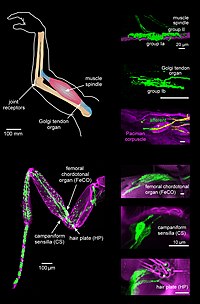
Photo from wikipedia
Persons with lower limb amputation (LLA) are at high risk for developing chronic low back pain (LBP), often with biomechanical factors considered as likely contributors. Here, trunk and pelvis kinematics,… Click to show full abstract
Persons with lower limb amputation (LLA) are at high risk for developing chronic low back pain (LBP), often with biomechanical factors considered as likely contributors. Here, trunk and pelvis kinematics, muscle forces, and resultant spinal loads were characterized in persons with LLA, with and without chronic LBP. Thirty-five persons with unilateral LLA - 19 with chronic LBP ("LLA-cLBP"), 16 without LBP ("LLA-nLBP") - and 15 (uninjured) persons without LBP ("CTR-nLBP") walked overground (1.3 m/s) while thorax and pelvis kinematics were tracked (and ranges of motion [ROM] computed), and used as inputs for a non-linear finite element model of the spine to estimate global and local muscle forces, and resultant spinal loads. In the frontal and transverse planes, thorax ROM were up to 66.6% smaller in LLA-nLBP versus LLA-cLBP (P < 0.001) and CTR-nLBP (P < 0.001). In the sagittal plane, pelvis ROM was 50.4% smaller in LLA-nLBP versus LLA-cLBP (P = 0.014). LLA-cLBP exhibited 45.5% and 34.2% greater peak local and global muscle forces, respectively, versus CTR-nLBP (P < 0.011). Up to 48.1% greater spinal loads were observed in LLA-cLBP versus CTR-nLBP (P < 0.013); peak compression and local muscle forces were respectively 20.2% and 41.0% larger in LLA-nLBP versus CTR-nLBP (P < 0.005). Despite differences in trunk and pelvis kinematics between LLA-cLBP and LLA-nLBP, trunk muscle forces and spinal loads were similar (P > 0.101) between these groups. Similar loading parameters regardless of LBP presence, while highly dependent on trunk muscle activation strategies, may mitigate further accumulation of mechanical fatigue. It remains important to understand the temporality of loading with respect to LBP onset following LLA.
Journal Title: Journal of biomechanics
Year Published: 2022
Link to full text (if available)
Share on Social Media: Sign Up to like & get
recommendations!